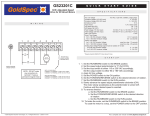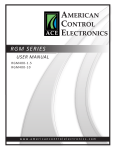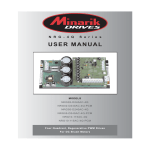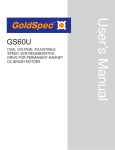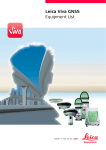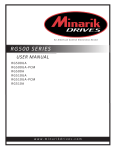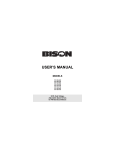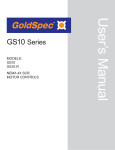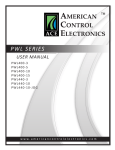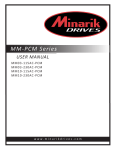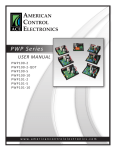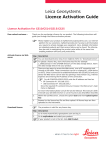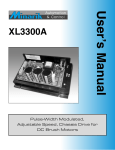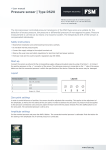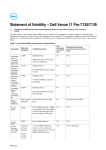Transcript
C O N N E C T I O N S TQ LIMIT ACCEL DECEL IR COMP MIN SPD MAX SPD 1 S T E P 2 STEP #1 R501 230 - 115 ARMATURE VOLTAGE SWITCH (SW501) 90 or 180 VDC S T E P # 3 WIRE THE CONTROL AS SHOWN THROUGH THE CONDUIT HOLES IN THE BOTTOM PLATE. POWER REMOVE THE SIX (6) PHILLIPS SCREWS ON THE FRONT CASE. SW501 MOV501 # 4 ASSURE THAT THE VOLTAGE SWITCH SETTINGS ARE CORRECT (SW501 & SW502) C503 G U I D E R502 S T A R T MOV502 Q U I C K SO502 T501 AC LINE VOLTAGE SWITCH (SW502) 115 or 230 VAC S3 S2 S1 NEMA4X SCR MOTOR CONTROLS 90 - 180 SW502 GS10 & GS10-R F502 ON L2 FRM SW L1 A2 TO SW A1 L2 TO SW L1 A2 FRM SW A1 OFF ADJUSTABLE SPEED DC MOTOR CONTROL # 5 REPLACE SIX SCREWS ON FRONT CASE & FIVE SCREWS ON BOTTOM PLATE. A1 A2 L1 L2-230 0 4 SPEED S T E P TB501 F2 The field output is for shunt wound motors only. Do not make any connections to F1 and F2 when using a permanent magnet (PM) motor. For field motor connections, see "Field Voltage" in Specifications box below. F1 2 3 1 7 8 9 3 F501 MOV503 L2-115 FIELD OUTPUT CONNECTIONS 4 5 6 NOTE: THE TWO SHORTER SCREWS (#6 - 32 x 2 ½) ON THE FRONT CASE ARE USED AT HOLE LOCATIONS 5 & 6. + 230 VAC 115 VAC EARTH GROUND (GREEN SCREW) 6 5 O P E R A T I O N CUSTOMER SUPPLIED WATERTIGHT CORD CONNECTORS (2) G S 10 Non-Reversing Speed Control 1. 2. 3. 4. 1 S T E P # 2 REMOVE THE FIVE (5) PHILLIPS SCREWS ON THE BOTTOM PLATE. FIELD OUTPUT 2 BOTTOM PLATE 3 CUSTOMER SUPPLIED WATERTIGHT CORD CONNECTORS (2) 4 5 DO NOT REMOVE THE THREE (3) SCREWS SECURING THE BOTTOM PLATE TO THE HEATSINK © 2009 Applied Industrial Technologies, Inc. All Rights Reserved. C-0209-11-5139 Set the speed adjust dial to “0” (full CCW). Apply AC line voltage. Set the POWER switch to the ON position. Slowly advance the speed adjust potentiometer CW. The motor slowly accelerates as the potentiometer is turned CW. Continue until the desired speed is reached. 5. To coast the motor to a stop, turn the speed adjust potentiometer to “0” or set the POWER switch to the OFF position. G S 10-R Reversing Speed Control 1. Set the FORWARD/OFF/REVERSE switch to the OFF position. 2. Set the speed adjust potentiometer to “0” (full CCW). 3. Apply AC line voltage. 4. Set the FOWARD/OFF/REVERSE switch to the desired direction of rotation. 5. Slowly advance the speed adjust potentiometer CW. The motor slowly accelerates as the potentiometer is turned CW. Continue until the desired speed is reached. 6. To coast the motor to a stop, turn the speed adjust potentiometer to “0” or set the FORWARD/OFF/REVERSE switch to the OFF position. LINE VOLTAGE INPUT (115 or 230 VAC) MOTOR ARMATURE S P E C I F I C A T I O N S AC Line Voltage . . .115 VAC or 230 VAC, ±10%, 50/60 Hz, single phase Horsepower Range with 115 VAC applied . . . . . . . . . . . . . . . . .1/8 - 1 HP Horsepower Range with 230 VAC applied . . . . . . . . . . . . . . . . .1/4 - 2 HP Maximum Armature Current . . . . . . . . . . . . . . . . . . . . . . . . . . . . . .10 ADC Maximum Field Current . . . . . . . . . . . . . . . . . . . . . . . . . . . . . . . . . .1 ADC Field Voltage for 115 VAC Input . . . . . . .50 VDC (F1 to L1); 100 VDC (F1 to F2) for 230 VAC Input . . . . . .100 VDC (F1 to L1); 200 VDC (F1 to F2) Form Factor . . . . . . . . . . . . . . . . . . . . . . . . . . . . . . . . .1.37 at base speed Analog Input Voltage Range (signal must be isolated; S1 to S2): for 0 - 90 VDC Armature Voltage . . . . . . . . . . . . . . . . .0 - 1.4 VDC for 0 - 180 VDC Armature Voltage . . . . . . . . . . . . . . . .0 - 2.8 VDC Input Impedance (S1 to S2) . . . . . . . . . . . . . . . . . . . . . . . . . . . . .3M ohms Load Regulation . . . . . . . . . . . . . . . . . . . . . . . . .1% base speed or better Style . . . . . . . . . . . . . . . . . . . . . . . . . . . . . . . . . . . . . . . . . . . . . . .NEMA 4X 7. To reverse direction: a. Set the FORWARD/OFF/REVERSE switch to the OFF position. b. After the motor comes to a complete stop, set the FORWARD/OFF/REVERSE switch to the desired direction of rotation. For a complete user manual visit www.Applied.com/gsmum
